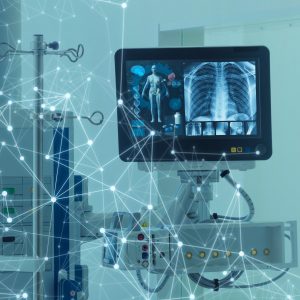
The future of health is digital and it is also personal, as health, or absence of health, is a deeply personal experience. And we are starting to see more personalization in the multitude of new solutions in the general health technology and healthcare marketplace.
What is DigitalHealth?
DigitalHealth is a broad term that applies to all technologies that engage patients around their health and wellness. The vast DigitalHealth landscape includes tech infrastructure like existing health information technology and telecommunications, health tech disruptors like Digital Therapeutics, software, web applications and mobile apps (for example telehealth or telemedicine). DigitalHealth also includes devices, sensors and wearables, personalized medicine and genetics. Some consider combinations of digital tools and more traditional technologies to also fit under the DigitalHealth umbrella. Examples of these combo applications would be innovative retail clinics, at home testing, digitally-assisted coaching and mental health counseling and smart apparel.
2019 Trends and 2020 Expectations
As an industry observer, social media influencer and Innovation Catalyst, I attend numerous industry conferences and events every year, providing coverage on social media and engaging in the conversations on-site and online. I regularly write on various topics in Healthcare and Life Sciences and I talk to HealthTech and DigitalHealth leaders and innovators every day.
A lot of the DigitalHealth trends we’ve seen in 2019 will continue and even accelerate in 2020 and beyond. As we start the next decade of industry innovation, here is my list of top 8 DigitalHealth predictions for the next year, with commentary on some notable highlights I’ve seen in 2019.
I’ve organized this list of predictions by their position along the continuum of care. This is how I personally think about health and technology and how I gauge my particular interest in getting involved with them – I want to contribute as much as possible to the innovation at the front end of the health care continuum.
1. Disease Prevention

Historically, in the traditional healthcare model (also known as a “sick-care” model), the industry has been focused on downstream interventions to provide access to care and treatment of disease. Over the past decade, there has been a paradigm shift towards disease prevention and increased focus on health and wellbeing as important elements of healthcare. This shift has become possible with the rise of DigitalHealth and with consumerization of healthcare. People have become more health conscious, patients now demand access to their health data and are empowered to advocate for themselves, and many physicians embrace principles of participatory medicine.
This paradigm shift gives the healthcare industry the opportunity to build new models of care and to respond to new demands from patients and physicians. The new generation of health conscious consumers are more likely to choose healthier lifestyle choices and seek out alternative treatments and wellness options beyond traditional medicine, such as yoga, meditation, and DigitalHealth solutions to weight-loss, mental health and nutrition, as well as to keep track of heart rate and blood sugar. We are moving closer to DigitalHealth-driven prevention being a clinical reality, and expectations for effective, efficient and cost-conscious digital healthcare have never been higher.
2. Reducing Employer Healthcare Costs
What used to be a rare perk by hot tech companies like Google, technology-enabled employee health and wellness programs are now a much more frequent occurrence. The onsite health clinics are designed to save money for employers by increasing employee attendance at work by saving time on off-site medical appointments, but they also emphasize preventative healthcare and improve patient experience.

According to a survey by Mercer, one-third of U.S. employers with at least 5,000 employees offered general medical worksite clinics in 2017. This employer trend to deploy novel care delivery and DigitalHealth-enabled solutions to keep their workforce healthy and reduce overall healthcare costs will continue.
3. Artificial Intelligence for Early Diagnostics
Artificial Intelligence (AI) covers a wide spectrum of applications and capabilities. It is already impacting every major industry and is poised to become as fundamental to us as computing is today. Key elements of Artificial Intelligence will continue to be woven into countless aspects of our daily lives, from the home to the hospital, from the smartphone you carry to the automobile you drive.
I am particularly excited about using Artificial Intelligence for early diagnostics of disease. One aspect of this is imaging, where use of AI to assist radiologists in interpreting diagnostic imaging is rapidly gaining traction. Another area is the detection of neurological diseases through AI-based analysis of movement patterns or use of mobile devices. I anticipate seeing many more of these developments in 2020.
4. Digital Therapeutics

The digitization of health has been exploding over the last decade, from its early days of Quantified Self (QS), general wellness and health monitoring, to much more advanced technologies that can now provide evidence-based clinical interventions and disease treatments.
Digital Therapeutics (DTx) is a subset of Digital Health – a large and growing field encompassing a multitude of technologies, products and services across healthcare and wellness industries. There are two distinct categories of digital therapeutics. The first is comprised of therapies that extend the value of traditional pharmaceutical treatments. The second consists of therapies that could potentially replace traditional pharmaceuticals.
A recent report by Juniper Research found that the market for Digital Therapeutics will expand rapidly over the next 5 years, growing over 1,000% to reach more than $32 billion in revenues in 2024 with biggest applications for DTx projected to be diabetes and weight loss, generating more than $19 billion in the next 5 years.
While the term Digital Therapeutics may still be unfamiliar to many, these therapies are here to stay. Digital Therapeutics (DTx) are becoming a new category of medicine, poised to address chronic and other hard to treat conditions. While much work remains for digital therapies to be integrated into and across the traditional healthcare ecosystem, Digital Therapeutics will “increasingly influence the way healthcare is delivered and consumed across the world”.
Read more about Digital Therapeutics.
5. Care Personalization with 3D Printing

The 3D printing industry is estimated to grow to approximately $6 billion by 2024, according to the 3D Printing Progress. Prosthetics, hip and knee replacements and other implants, tissue, medicines and hearing aids are expected to drive 3D printed products in life sciences and biotech.
With 3D printing technology, objects are created by depositing materials onto a substrate. This technology is hugely versatile, as the deposited materials can be plastics, metals, powders, ceramics, liquids or living cells. The 3D printing process is accurate, repeatable, scalable, but also cost-effective for small production runs or even single prints of highly customized parts.
A subset of 3D printing used to produce natural tissues is called bioprinting. In this process, special biomaterial such as cells and growth factors are combined to form bioink. To learn more about this emerging trend, take a look at CELLINK, the first bioink company that focuses on the development and commercialization of bioprinting technologies that will allow researchers to 3D print human tissues and organs for the development of pharmaceutical and cosmetic treatments.
There are many current medical applications of 3D printing, including Prosthetics, Dental Applications, Tissue, Organs, Bones, Muscle and Skin. Beyond actual use in medical treatment, this technology plays a role in medical research, surgical planning, medical education and training and even in drug delivery.
The emerging applications of 3D printing technology in the medical space that we will see in 2020 and beyond include ligaments, fully functional bionic eye, entire complex organs, like lungs, and 3D-printing of personalized drug delivery devices, not just medications themselves.
The precision, speed and cost effectiveness of 3D printing ushers a new era of personalized patient care.
Read more about 3D Printing.
6. Creating Alternatives to Opioids
As the death toll from prescription opioid overdose continues to rise, Digital Technology could play a significant role in ending America’s opioid epidemic. As the healthcare industry seeks alternatives to opioids to manage acute and chronic pain, PTSD and other medical and mental health conditions, an array of technologies has emerged.
The Virtual Reality (VR) applications to manage chronic pain and reduce distress are gaining traction in hospitals. Using VR for PTSD increased in 2019 and use of such Digital Therapeutics will continue to grow in 2020, including novel approaches for conditions such as Chronic Obstructive Pulmonary Disorder (COPD) and developmental disorders.
A wide range of alternatives to opioids is emerging, from using nerve stimulation to block pain signals to adopting a Big Data approach to chronic pain management to combining non-invasive alternatives to surgery to reduce chronic musculoskeletal pain. This combination approach would include sensor-guided exercise therapy, patient education, cognitive behavioral therapy and psychosocial support through a personal coach and team-based interactions.
Another emergent area that shows promise is pharmacogenomics – a combination of pharmacology and genomics used to develop safe and effective medications and optimal doses for personalized pain management protocols.
7. Connected Health Care and the Internet of Medical Things
Increasingly, the term “Connected Health” is part of the healthcare innovation conversation. We’ve definitely seen this in 2019, including at the HIMSS Connected Health Conference in Boston in October.
The Connected Health field is a collection of technologies, sensors, devices, intelligent communications and data sharing designed to deliver actionable insights in order to improve patient outcomes. It’s an enabling technology for more integrated care, better-informed health and wellness decision making and improved access to quality healthcare.

The whole Connected Health ecosystem is continuously evolving through the latest innovations in smart sensors, connected devices, communication infrastructure, software and apps. It has the potential to enable a paradigm shift in healthcare from treatment of disease and symptom management to focus on prevention and empowering individuals to be in control of their health. Continuous near real-time or real-time data collection will drive patient-centered care and over time, benefit all the stakeholders in the healthcare ecosystem. The MarketResearch.com report states that the Internet of Things in Healthcare is expected to reach $117 billion by 2020.
Read more about Connected Health Care and the Internet of Medical Things.
8. Digitizing Clinical Trials
Digitizing Clinical Trials presents a real opportunity for the development of better drugs by validating them faster and across a wider, more diverse patient population.
Clinical Trials are necessary as they assess the safety and efficacy of drug candidates, but the traditional, lengthy and expensive process is a barrier for novel therapies and those addressing smaller markets, like rare diseases. Virtual Clinical Trials will allow vital and sometimes life-saving medications to be available to patients in need faster. Virtual, or remote, clinical trials are starting to gain traction. They can help increase trial enrollment, decrease drop-out rates and potentially gather more data with better patient comfort. Trial measurements, such as vital signs, could be automatically captured by wearable devices and seamlessly shared with clinical and research teams. AI and other technologies can identify changes in patient behavior and activity patterns and immediately alert study investigators.
Another important advantage of decentralized clinical trials is the potential for continuous outcome measurement, which may provide a better assessment of the drug efficacy compared to a less frequent measurements taken during hospital visits, which is typical in traditional trial protocols.
Bonus: A New Generation of Leaders
In order to successfully govern the vast DigitalHealth landscape in the next decade and beyond, we will need a new generation of leaders. Leaders who are equipped to manage continuous change and innovation.
Because DigitalHealth technologies can enable patients to receive care without physically going to a doctor’s office or a hospital, health-care professionals will themselves need to have the digital skills to guide patients in understanding and using digital solutions to improve their health.
The ultimate power of DigitalHealth technologies is in better engaging patients, empowering them to take control of their health and making them co-designers of care. Through shared decision-making between health professionals, patients and care partners, all become collaborators in a patient’s journey back to health, while providing empathy and a human touch in support of patients’ overall well-being.
Read more about the Future of Life Sciences here
